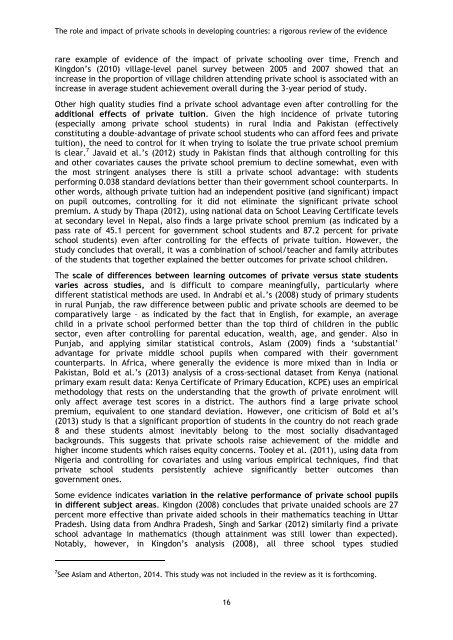private-schools-full-report
private-schools-full-report
private-schools-full-report
Create successful ePaper yourself
Turn your PDF publications into a flip-book with our unique Google optimized e-Paper software.
The role and impact of <strong>private</strong> <strong>schools</strong> in developing countries: a rigorous review of the evidence<br />
rare example of evidence of the impact of <strong>private</strong> schooling over time, French and<br />
Kingdon’s (2010) village-level panel survey between 2005 and 2007 showed that an<br />
increase in the proportion of village children attending <strong>private</strong> school is associated with an<br />
increase in average student achievement overall during the 3-year period of study.<br />
Other high quality studies find a <strong>private</strong> school advantage even after controlling for the<br />
additional effects of <strong>private</strong> tuition. Given the high incidence of <strong>private</strong> tutoring<br />
(especially among <strong>private</strong> school students) in rural India and Pakistan (effectively<br />
constituting a double-advantage of <strong>private</strong> school students who can afford fees and <strong>private</strong><br />
tuition), the need to control for it when trying to isolate the true <strong>private</strong> school premium<br />
is clear. 7 Javaid et al.’s (2012) study in Pakistan finds that although controlling for this<br />
and other covariates causes the <strong>private</strong> school premium to decline somewhat, even with<br />
the most stringent analyses there is still a <strong>private</strong> school advantage: with students<br />
performing 0.038 standard deviations better than their government school counterparts. In<br />
other words, although <strong>private</strong> tuition had an independent positive (and significant) impact<br />
on pupil outcomes, controlling for it did not eliminate the significant <strong>private</strong> school<br />
premium. A study by Thapa (2012), using national data on School Leaving Certificate levels<br />
at secondary level in Nepal, also finds a large <strong>private</strong> school premium (as indicated by a<br />
pass rate of 45.1 percent for government school students and 87.2 percent for <strong>private</strong><br />
school students) even after controlling for the effects of <strong>private</strong> tuition. However, the<br />
study concludes that overall, it was a combination of school/teacher and family attributes<br />
of the students that together explained the better outcomes for <strong>private</strong> school children.<br />
The scale of differences between learning outcomes of <strong>private</strong> versus state students<br />
varies across studies, and is difficult to compare meaning<strong>full</strong>y, particularly where<br />
different statistical methods are used. In Andrabi et al.’s (2008) study of primary students<br />
in rural Punjab, the raw difference between public and <strong>private</strong> <strong>schools</strong> are deemed to be<br />
comparatively large – as indicated by the fact that in English, for example, an average<br />
child in a <strong>private</strong> school performed better than the top third of children in the public<br />
sector, even after controlling for parental education, wealth, age, and gender. Also in<br />
Punjab, and applying similar statistical controls, Aslam (2009) finds a ‘substantial’<br />
advantage for <strong>private</strong> middle school pupils when compared with their government<br />
counterparts. In Africa, where generally the evidence is more mixed than in India or<br />
Pakistan, Bold et al.’s (2013) analysis of a cross-sectional dataset from Kenya (national<br />
primary exam result data: Kenya Certificate of Primary Education, KCPE) uses an empirical<br />
methodology that rests on the understanding that the growth of <strong>private</strong> enrolment will<br />
only affect average test scores in a district. The authors find a large <strong>private</strong> school<br />
premium, equivalent to one standard deviation. However, one criticism of Bold et al’s<br />
(2013) study is that a significant proportion of students in the country do not reach grade<br />
8 and these students almost inevitably belong to the most socially disadvantaged<br />
backgrounds. This suggests that <strong>private</strong> <strong>schools</strong> raise achievement of the middle and<br />
higher income students which raises equity concerns. Tooley et al. (2011), using data from<br />
Nigeria and controlling for covariates and using various empirical techniques, find that<br />
<strong>private</strong> school students persistently achieve significantly better outcomes than<br />
government ones.<br />
Some evidence indicates variation in the relative performance of <strong>private</strong> school pupils<br />
in different subject areas. Kingdon (2008) concludes that <strong>private</strong> unaided <strong>schools</strong> are 27<br />
percent more effective than <strong>private</strong> aided <strong>schools</strong> in their mathematics teaching in Uttar<br />
Pradesh. Using data from Andhra Pradesh, Singh and Sarkar (2012) similarly find a <strong>private</strong><br />
school advantage in mathematics (though attainment was still lower than expected).<br />
Notably, however, in Kingdon’s analysis (2008), all three school types studied<br />
7 See Aslam and Atherton, 2014. This study was not included in the review as it is forthcoming.<br />
16


